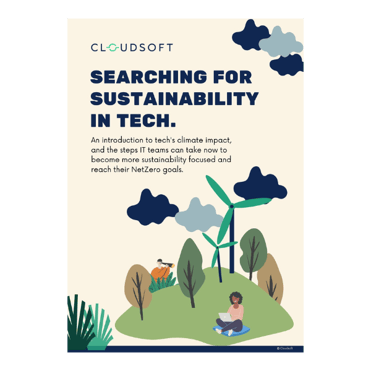What have zombies got to do with sustainability?
/4.png?width=200&name=4.png)
Environmental, Social and, Grrrr… zombies?
Reports this week that data centres are becoming ‘energy vampires’ puts the tech industry’s spiralling energy consumption into sharp relief.
According to The Telegraph, UK data centre energy consumption is now even preventing housing from being built, as grid infrastructure cannot generate and deliver enough power for both.
Data centre growth in the UK set to be focused on London, which is already the data centre hub of Europe. Its attractiveness can be put down to a combination of the size of its financial sector and its extensive fibre capacity.
And of course all of this energy consumption has a huge environmental impact too.
Globally, IT is set to consume 10% of global electricity supply by 2030, matching carbon bad-boy aviation for greenhouse gas emissions. This means tech organisations have a huge opportunity to contribute towards NetZero goals - but it will require tackling some monsters along the way.
The energy vampires hidden amongst us

The massive energy needs of data centres are well documented. The National Grid puts UK data centre usage at 2.5% of total electricity consumption - and estimates it could reach 6% by 2030.
This power isn’t just required to keep the servers running, but also to run cooling systems so the servers perform efficiently and don’t set on fire.
About 40% of a typical data centre’s power consumption is used on running the air conditioning and cooling systems. To reduce this, data centre operators are experimenting with different cooling methods, such as immersion cooling or building in colder climates. Microsoft even submerged a small data centre in the sea off the coast of Scotland, with promising results.
Not all data centres are equally energy intensive - AWS estimates that its hyperscale infrastructure is 3.6x more efficient than the average US data centre. Hyperscale cloud providers make their operations more sustainable by consuming huge amounts of renewable energy, but they are not just consumers - they are also producers of it, contributing renewable power back to the grid.
Time to become a zombie hunter?
It’s not just the infrastructure that’s energy hungry.
Zombie workloads have a huge environmental impact, mindlessly consuming huge chunks of raw compute power. It's common that a big business with 1000s of applications will have lots of zombie applications - sometimes as high as 20%.

A zombie application is one which hasn't evolved with technology. It may be poorly documented, or its full scope may be unknown, making it feel risky to update or even switch off.
But that unknown is precisely why organisations should be proactive zombie hunters. Whilst it's running, it's consuming power, cash and time. If it's business critical, then that's ok - but often these applications are just sitting there, consuming with no real output and could actually be low hanging fruit when it comes to making your overall estate more sustainable and cost effective.
Want to learn more about sustainability and tech?

‘Searching for Sustainability in Tech’ is an introduction to tech's climate impact, and the steps IT teams can take now to become more sustainability focused and reach their NetZero goals.
Download the guide to understand:
- tech's climate impact;
- why sustainability is a strategic imperative;
- different types of emissions, and how to reduce them;
- the role of cloud computing in sustainability.